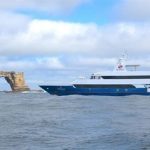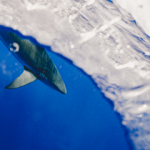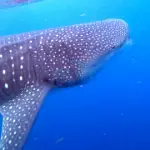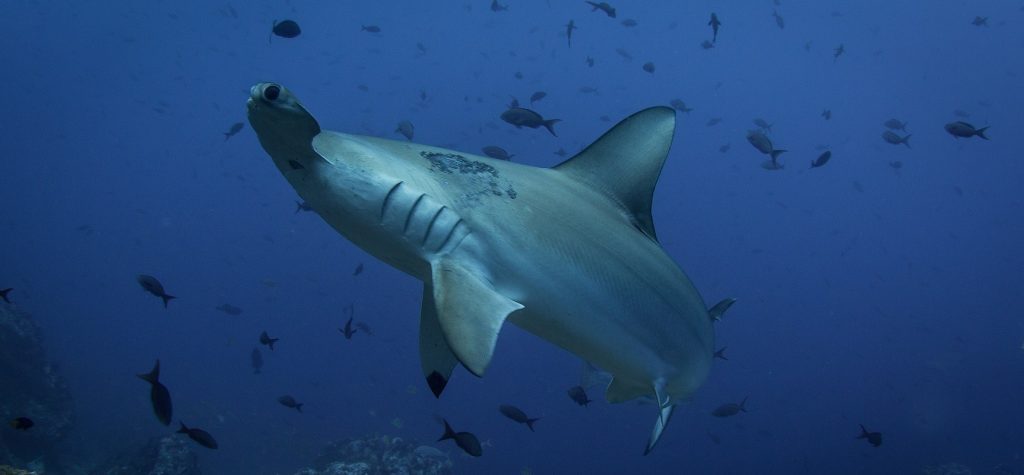
If you are planning a scuba diving trip to the Galapagos Islands, you are probably wondering when is the best time of year to scuba dive Galapagos.
The best time of year to scuba dive Galapagos is June to October, as the nutrient rich waters result in an explosion of marine life including giant mantas, turtles, eagle rays, large fish schools, whales, sea lions and larger numbers of hammerheads and seeing the arrival of adult whale sharks.
If you want big marine life, like whale sharks, hammerheads and manta rays, then book your Galapagos scuba diving trip in June, July, August or September. You will also see the resident turtles and sealions too, but be prepared for choppier seas and milder weather – 23-25°C (73-77°F).
If you suffer from seasickness on a liveaboard, the best time of year to scuba dive Galapagos is January to April, as seas are calmer, and although there’s less marine life, diving in the Galapagos at this time is still possibly better than most other dive destinations during their high season.
There are two distinct seasons in the Galapagos Islands, the wet warm season from December through May, and the dry cool season from June through November. For either season scuba diving in the Galapagos, the best way to experience the scuba diving in Galapagos is on a dive liveaboard (especially if you want to dive Darwin and Wolf Islands).
If you would like to dive Galapagos on a liveaboard you can view these using the following window:
The following two summaries are of what it’s like to scuba dive Galapagos, but I also include what it’s like to dive in Galapagos in each month with pros and cons for each month of the year below too. But before that, take a look at this amazing footage of the Galapagos experience both above and below water:
Scuba diving Galapagos December through May
Scuba diving Galapagos from December to May is the warm wet season, is good for manta rays at Isabela island and large numbers of hammerhead sharks at Wolf and Darwin Islands. Better if you get sea sick as seas are calmer and 24-26°C (75-79°F) and air temperatures are from 26-27°C (79-81°F).
Scuba diving Galapagos in June through November
Scuba diving Galapagos from June to November is the cool dry season, is good for whale sharks, loads of fish and hammerhead sharks at Wolf and Darwin Islands. Not good if you get sea sick, as seas are choppier and cooler at 22-24°C (73-74°F) and air temperatures are from 23-26°C (73-79°F).
Scuba diving Galapagos January
Scuba diving Galapagos in January is the warm wet season ideal to see manta rays at Isabela island and hammerhead sharks at Wolf and Darwin Islands. You will also enjoy calmer, warm seas at around 25°C (77°F) and air temperatures will be around 27°C (81°F).
- Pros of scuba diving Galapagos in January: Manta rays; Hammerheads; Warm season 27°C (81°F); Warmer waters 25°C (77°F); Calmer seas; Better visibility; Turtles; Sealions; Marine iguanas.
- Cons of scuba diving Galapagos in January: Wet season with more rain; No whale sharks; less fish life.
Scuba diving Galapagos February
Scuba diving Galapagos in February is the warm wet season and a good month to see manta rays at Isabela Island and hammerhead sharks at Wolf and Darwin Islands. You will also enjoy calmer, warm seas at around 26°C (79°F) and air temperatures will be around 27°C (81°F).
- Pros of scuba diving Galapagos in February: Manta rays; Hammerheads; Warm season 27°C (81°F); Warmer waters 26°C (79°F); Calmer seas; Better visibility; Turtles; Sealions; Marine iguanas.
- Cons of scuba diving Galapagos in February: Wet season with more rain; No whale sharks; less fish life.
Scuba diving Galapagos March
Scuba diving Galapagos in March is the warm wet season a good for diving with manta rays at Isabela Island and hammerhead sharks at Wolf and Darwin Islands. You will also enjoy calmer, warm seas in March at around 26°C (79°F) and air temperatures will be around 27°C (81°F).
- Pros of scuba diving Galapagos in March: Manta rays; Hammerheads; Warm season 27°C (81°F); Warmer waters 26°C (79°F); Calmer seas; Better visibility; Turtles; Sealions; Marine iguanas.
- Cons of scuba diving Galapagos in March: Wet season with more rain; No whale sharks; less fish life.
Scuba diving Galapagos April
Scuba diving Galapagos in April is the warm wet season and good for diving with manta rays at Isabela Island and for seeing hammerhead sharks at Wolf and Darwin Islands. In April seas are calmer and warmer at around 25°C (77°F) and air temperatures will be around 26.5°C (79.7°F).
- Pros of scuba diving Galapagos in April: Manta rays; Hammerheads; Warm season 27°C (81°F); Warmer waters 25°C (77°F); Calmer seas; Better visibility; Turtles; Sealions; Marine iguanas.
- Cons of scuba diving Galapagos in March: Wet season with more rain; No whale sharks; less fish life.
Scuba diving Galapagos May
Scuba diving Galapagos in May is the warm wet season and good for mantas at Isabela Island, you may also see early arriving whale sharks as well as increasing numbers of hammerheads at Darwin and Wolf. In May seas are calmer and warmer at 25°C (77°F) and air temperatures at 27°C (81°F).
- Pros of scuba diving Galapagos in May: Manta rays; Hammerheads; Possible early arriving whale sharks; Warm season 27°C (81°F); Warmer waters 25°C (77°F); Calmer seas; Better visibility 12-30 metres (40-100 feet); Turtles; Sealions; Marine iguanas.
- Cons of scuba diving Galapagos in May: Wet season with more rain; less fish life.
Scuba diving Galapagos June
Scuba diving Galapagos in June is when seas get rougher and cool down to 24°C (75°F), air temperatures are 25°C (77°F), but is when more nutrients are in the water and larger numbers of fish life. In June you can still see hammerheads at Darwin and Wolf, and more chance of whale sharks too.
- Pros of scuba diving Galapagos in June: Manta rays; Whale sharks; Larger numbers of hammerheads; Calmer seas; Better visibility; Turtles; Sealions; Marine iguanas.
- Cons of scuba diving Galapagos in June: Cool wet season 25°C (77°F); Rougher seas; Cooler waters 24°C (75°F); Cooler air temperature.
Scuba diving Galapagos July
Scuba diving Galapagos in July is the cool dry season when seas are rougher and cool to 23°C (73°F), air temperatures are 23°C (73°F), but is when more nutrients are in the water and larger numbers of fish life. In July you can see hammerheads and whale sharks at Darwin and Wolf.
- Pros of scuba diving Galapagos in July: Dry season; Manta rays; Whale sharks; Larger numbers of hammerheads; Large fish numbers; Turtles; Sealions; Marine iguanas.
- Cons of scuba diving Galapagos in July: Cool season 23°C (73°F); Cooler waters 23°C (73°F); Choppier seas.
Scuba diving Galapagos August
Scuba diving Galapagos in August is the cool dry season when seas are rougher and cool to 23°C (73°F), air temperatures are 23°C (73°F), but is when more nutrients are in the water and larger numbers of fish life. In August you can see hammerheads and whale sharks at Darwin and Wolf.
- Pros of scuba diving Galapagos in August: Dry season; Whale sharks; Larger numbers of hammerheads; Large fish numbers; Turtles; Sealions; Marine iguanas.
- Cons of scuba diving Galapagos in August: Cool season 23°C (7°F); Cooler waters 23°C (73°F); Choppier seas.
Scuba diving Galapagos September
Scuba diving Galapagos in September is the cool dry season when seas are rougher and cool to 22°C (72°F), air temperatures are 24°C (75°F), but is when more nutrients are in the water and larger numbers of fish life. In September you can see hammerheads and whale sharks at Darwin and Wolf.
- Pros of scuba diving Galapagos in September: Dry season; Whale sharks; Larger numbers of hammerheads; Large fish numbers; Turtles; Sealions; Marine iguanas.
- Cons of scuba diving Galapagos in September: Cool season 22°C (72°F); Cooler waters 24°C (75°F); Choppier seas.
Scuba diving Galapagos October
Scuba diving Galapagos in October is the cool dry season when seas are rougher and cool to 23°C (73°F), air temperatures are 24°C (75°F), but is when more nutrients are in the water and larger numbers of fish life. In October you can see hammerheads and whale sharks at Darwin and Wolf.
- Pros of scuba diving Galapagos in October: Dry season; Manta rays; Whale sharks; Larger numbers of hammerheads; Large fish numbers; Turtles; Sealions; Marine iguanas.
- Cons of scuba diving Galapagos In October: Cool season 24°C (75°F); Cooler waters 23°C (73°F); Choppier seas.
Scuba diving Galapagos November
Scuba diving Galapagos in November is the cool dry season when seas are rougher and cool to 23°C (73°F), air temperatures are 26°C (79°F), but is when more nutrients are in the water and larger numbers of fish life. In November you can see hammerheads and whale sharks at Darwin and Wolf.
- Pros of scuba diving Galapagos in November: Dry season; Manta rays; Whale sharks; Hammerheads; Large fish numbers; Turtles; Sealions; Marine iguanas.
- Cons of scuba diving Galapagos in November: Cool season 26°C (79°F); Cooler waters 23°C (73°F); Choppier seas.
Scuba diving Galapagos December
Scuba diving Galapagos in December is warm wet season ideal to see manta rays at Isabela island and large numbers of hammerhead sharks at Wolf and Darwin Islands. You will also enjoy calmer seas, which are still cool at 24°C (75°F) and air temperatures are warming and will be around 26°C (79F).
- Pros of scuba diving Galapagos in December: Manta rays; Hammerheads; Wet warm season 26°C (79°F); Slightly warmer waters 24°C (75°F); Calmer seas; Better visibility; Turtles; Sealions; Marine iguanas.
- Cons of scuba diving Galapagos in December: Wet season with more rain; No whale sharks; less fish life.
Table of Galapagos liveaboards
This list of Galapagos liveaboards is in descending customer rating order, so the liveaboards with the highest customer rating will be at the top of the list. To filter this table for the features that are important for your Galapagos liveaboard trip, select from the list of filters below.
| Discover Liveaboard | Customer Reviews | Price Per Day | |
|---|---|---|---|
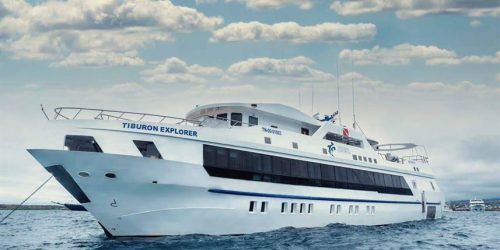 |
Review: MV Tiburon Explorer; Book: MV Tiburon Explorer | 9.7 Exceptional | from £612; $747; €698 |
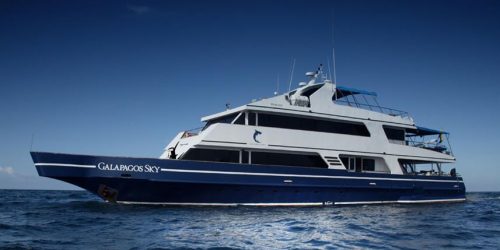 |
Review: MV Galapagos Sky; Book: MV Galapagos Sky | 9.5 Exceptional | from £708; $864; €807 |
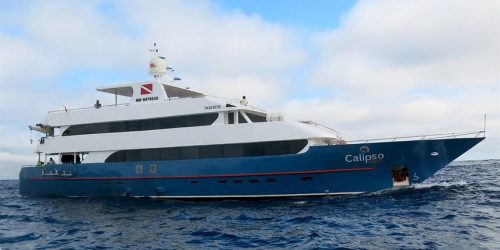 |
Review: MV Calipso; Book: MV Calipso | 9.4 Superb | from £658; $803; €750 |
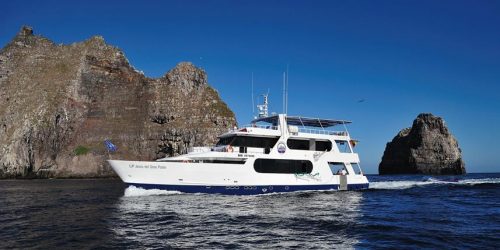 |
Review: MV Galapagos Aggressor III; Book: MV Galapagos Aggressor III | 9.1 Superb | from £580; $708; €661 |
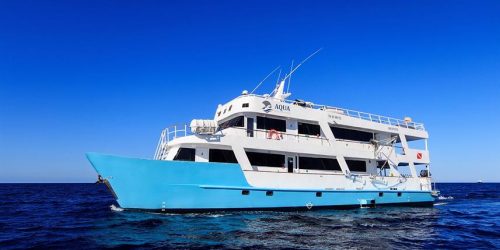 |
Review: MY Aqua; Book: MY Aqua | 9 Superb | from £457; $558; €521 |
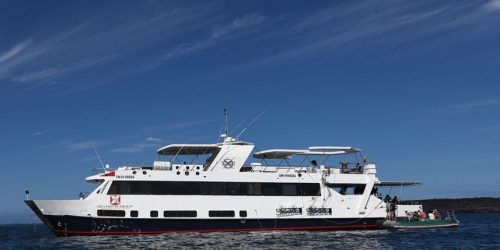 |
Review: MV Humboldt Explorer; Book: MV Humboldt Explorer | 8.9 Fabulous | from £489; $597; €557 |
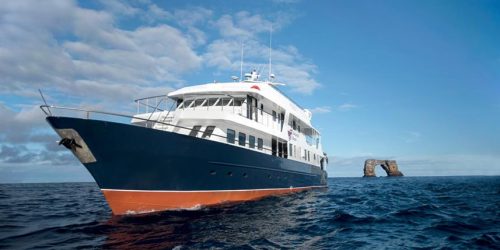 |
Review: MV Galapagos Master; Book: MV Galapagos Master | 8.6 Fabulous | from £459; $560; €523 |
- 1
- 2
Note: The above “Price Per Day” was correct at the time of producing this article, as was the exchange rate used to convert the GBP cost to US Dollars and Euros. For an up-to-date cost for your chosen liveaboard, please visit the “Book” link above.
I hope you enjoyed this article about what is the best time of year to scuba dive Galapagos?
I’d love to hear from you. Tell us about your adventures of diving and snorkeling, in the comments below. Please also share your photos. Either from your underwater cameras or videos from your waterproof Gopro’s!
If this article hasn’t answered all of your questions. If you have more questions either about snorkeling or scuba diving (or specifically about what is the best time of year to scuba dive Galapagos), please comment below with your questions.
There will also be many more articles about scuba diving (and snorkeling) for you to read and learn about these fabulous sports.
Have fun and be safe!

